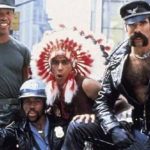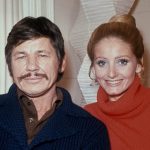During the 40s, 50s, and 60s, the world of cinema rules by one genre: Westerns. The hit formula that mixed open deserts and starry skies with mind-boggling gunfighting sequences and a hero that epitomized courage and daredevilry, and in some cases, even recklessness, worked every single time. And John Wayne was the king of this genre. His deep voice combined with his brooding looks made him the ideal Western hero.
For many, many decades, Wayne was the symbol of American Freedom. Through films like Red River, True Grit, and The Searchers, Wayne not only exhibited his acting range but also become etched in our memories as the man who defined the American Western protagonist. It is, therefore, not very surprising that when we think of Westerners, cowboys, and gunslingers today, we think foremostly of John Wayne. In this video, we tell you some interesting facts about the star and also shed light on his ugly side.
He Wanted to Be a Professional Football Player
John Wayne was born Marion Robert Morrison to Clyde Leonard Morrison and Mary Alberta Brown on May 26, 1907, in Winterset, Iowa. When he was seven years old, the family moved to California. As a child, Wayne’s best friend is a dog, Duke — the two are always together. Due to this love for his dog, Wayne becomes Duke.
Wayne had a towering personality since the very beginning, which made him a natural athlete. Wayne went to college at the University of Southern California on a football scholarship and majored in pre-law. He was an active member of Trojan Knights and Sigma Chi. At the time, it seemed that Wayne had a successful sports career in front of him. However, he suffered a bodysurfing accident, which led to a terrible collarbone injury.
After the incident, not only did all of Wayne’s football dreams come to an end, but his scholarship takes away from him and he dropped out of the university. This was the time of The Great Depression and Wayne was desperate for money. He took up a job as the Prop Guy for Fox Film Corporation. His injury may have quashed his football dreams, but he eventually got to play a football player in Brown of Harvard and Drop Kick.
His Struggle Lasted over a Decade
Like any other successful actor, Wayne too had to go through his days of struggle. It was director John Ford who discovered Wayne’s acting talent and offered him a small role in the 1928 silent film Mother Machree. During the shooting of the film, Wayne became close friends with Ford. It was Ford who introduced Wayne to Raoul Walsh who gave Wayne his first big break in The Big Trail. The film is a mediocre hit and does not establish Wayne as a star. However, it certainly made him a well-recognized face.
However, throughout the 1930s, Wayne kept waiting for his big break; unfortunately, it never came. The decade mostly saw him starring in low-budget Western movies. Though Wayne isn’t getting the kind of roles he wants, he uses the decade to his best advantage, devoting himself to studying the quintessential Western hero. It was during the 30s that Wayne developed the idiosyncratic walk that would eventually make him so famous. He also learned to do his own stunts. Wayne got his big break at just the end of the decade. In 1939, Ford offered him the role of The Ringo Kid in Stagecoach, and the film entirely changed his career, and all the work he had been putting in finally paid off.
Red River
Established Him as a Major Movie Star
Wayne enjoyed significant popularity during the early 40s. However, the film that established him as a major movie star came in 1948. Directed by Robert Hawks, Red River was a massive hit. The film narrated the story of Tom Dunson, played by John Wayne, and his son Matt Garth, played by Montgomery Cliff. Many believe that the film had very strong homosexual undertones. However, this was the 1940s and if the film had any hidden messages, they went unnoticed. Red River, however, was a major critical and commercial success and went on to win two Academy Awards. In 2008, the American Film Institute ranked the Red River as the fifth-greatest Western of all time. With Red River, Wayne impressed many people and one of these people was his old friend John Ford.
And
The Quiet Man
Changed His Image
After watching Wayne play Tom Dunson in Red River, Ford cast him in the 1952 film The Quiet Man, a film that was quite different from everything both Ford and Wayne had done in the past. In this romantic comedy, Wayne played the role of Sean Thornton, an ex-boxer who goes back to Ireland to purchase his family farm. The audiences were used to seeing Wayne firing shots in deserted streets and open deserts — The Quiet Man did the opposite.
It transports Wayne to a green and beautiful Ireland and the audiences were happily surprised. Moreover, it made him fall in love with the belle Mary Kate Danahar, played by Maureen O’Hara. The film was a hit, grossing $3.8 million at the box office. It won John Ford an Oscar for Best Director. Though the film did not win Wayne an Oscar, it most certainly played a key role in changing his image. After The Quiet Man, Wayne got many opportunities to explore his acting range further with varied roles.
John Wayne was a major movie star and people loved him. However, he was imperfect in his own ways. Did you know the man was often criticized for his far-right beliefs and that he was even accused of racism? We will get to John Wayne’s ugly side in just a short while. In the meanwhile, if you are enjoying this video, do not forget to like and subscribe to our channel.
Wayne Delivered Perfect Entertainment in
Rio Bravo
Wayne plays the lead in the 1959 Western Rio Bravo, a film that not only achieves commercial success but selects for the National Film Register due to its cultural, historical, and aesthetic significance. The actor portrayed the character of John T. Chance, the sheriff of the Texan town Rio Bravo who arrests a murderer and fends off the bad guy to ensure justice is served.
Rio Bravo is a fun film in a simple way – as a viewer, you won’t have gushed over it once the end credits rolled, but you were bound to enjoy it while it lasted. Outside the US, Rio Bravo raked mixed reviews in a way; some critics rated the movie well altogether, while others rated it as low as two on five but conceded that it entertaining enough to pass the time.
The story of Rio Bravo takes from a short story by the same name credited to a ‘B. H. McCampbell.’ The story played a big role in the film’s success, as one of the best parts about the production was the plot, which featured a band of misfits that gave way for abundant comedy. Later, in the biography Howard Hawks: The Silver Fox of Hollywood, we find out B. H. McCampbell was none other than Hawk’s eldest daughter, Barbara.
The Searchers
Features Wayne’s Best Performance to Date
Another masterpiece from the two-decade-long ‘Ford & Wayne’ partnership that produced more than 25 films was the 1956 Technicolor Western The Searchers. It’s the best Western of all time, The Searchers is a rare film that is a critical and commercial success in its era and is one of the greatest films 70 years later.
In The Searchers, Wayne delivers what can label as his acting career’s best performance. He plays the role of Ethan Edwards, a veteran who returns home after eight long years, only to witness the murder of his brother’s family and, rescue a niece who abduct. On a deeper level, the movie focuses on white settlers’ racist attitudes toward the native settlers and themes of abduction, captivity, and rape that white women.
Warner Bros distributed The Searchers, and in what was a first at the time, the production house produced and broadcast a behind-the-scenes program. The movie inspired several films over the later decades; in fact, the 2016 Canadian drama Searchers is partially based on it without the racism aspect.
True Grit
Won Him an Oscar, Finally
After most of Wayne’s golden years, as an actor are behind him, his skill was finally recognized with an Oscar. The 1969 Western True Grit brought home the Oscar for John Wayne, who played the role of Texan US Marshall Rooster Cogburn. The movie is a namesake of the 1968 novel by Charles Portis, on which it is based.
True Grit features Wayne as a tough-as-nails one-eyed veteran who has killed more than five dozen men in eight years, but all in the line of duty or self-defense. The character receives, and Wayne makes to reprise it in the 1975 sequel Rooster Cogburn. Wayne receives a Golden Globe for his performance in True Grit, but of course, the award overshadows the long-awaited Oscar.
His Political Beliefs and Racist Comments Got Him into Trouble
Wayne was a far-right supporter all the way, which was difficult at the time since Hollywood was flooded with far leftists. The actor, who was always at odds with other board members at the Screen Actors Guild, decided to change the way things were and cofounded the Motion Picture Alliance For The Preservation Of American Ideals to push back against the left movement at the time. Wayne also played a part in the blacklist of communists in Hollywood.
While Wayne’s political opinions raised questions, his racist remarks tarnished his image the most. In an interview, Wayne acknowledged the dissent in the black community, saying it was justified. Still, he backtracked by saying he believed in white supremacy till the day blacks were educated and deemed fit to assume authority. Not only did his comments spell trouble then, they recently stirred anger when they resurfaced, with many demanding the Orange County’s John Wayne Airport to be renamed.
Some of John Wayne’s personal and political beliefs and comments got him into trouble, but the man was a cinematic legend. His countless epic performances as the original protagonist in Hollywood to embody courage and heroism made him a star whose fame has continued well beyond his years. Wayne’s skill at his craft was so extraordinary that the man managed to win hearts with box-office successes as late as in his seventies. Wayne passed away from stomach cancer in 1979 at the UCLA Medical Center, leaving behind millions of fans with a legacy like none other.
If you enjoyed this video, don’t forget to hit the like button and subscribe to our channel. Also, hit the bell icon so we can update you about our latest videos.


